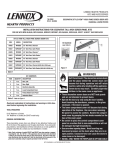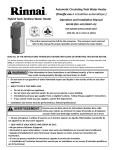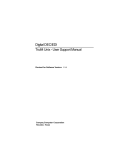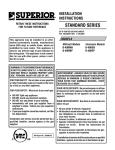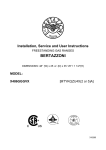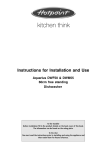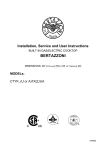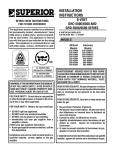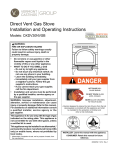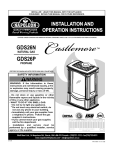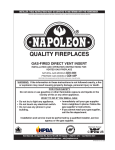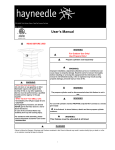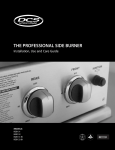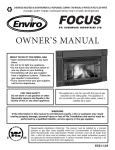Download Miele MNTSVBE User's Manual
Transcript
INSTALLATION INSTRUCTIONS B-VENT MULTI-OPEN ELITE® SERIES This appliance may be installed in an aftermarket permanently located, manufactured home (USA only) or mobile home, where not prohibited by local codes. This appliance is only for use with the type of gas indicated on the rating plate. This appliance is not convertible for use with other gases, unless a certified kit is used. In the Commonwealth of Massachusetts & New York: • Installation must be performed by a licensed plumber or gas fitter. See Table of Contents for location of additional New York & Commonwealth of Massachusetts requirements. B-VENTED GAS FIREPLACES P/N 850,025M REV. B 01/2007 MODELS Millivolt Models EBVSTNM EBVPFNM EBVCRNM EBVCLNM EBVSTPM EBVPFPM EBVCRPM EBVCLPM Electronic Models EBVSTNE EBVPFNE EBVCRNE EBVCLNE RETAIN THESE INSTRUCTIONS FOR FUTURE REFERENCE WARNING: IF THE INFORMATION IN THIS MANUAL IS NOT FOLLOWED EXACTLY, A FIRE OR EXPLOSION MAY RESULT CAUSING PROPERTY DAMAGE, PERSONAL INJURY OR LOSS OF LIFE. FOR YOUR SAFETY: Do not store or use gasoline or other flammable vapors or liquids in the vicinity of this or any other appliance. FOR YOUR SAFETY: What to do if you smell gas: • • • • DO NOT light any appliance. DO NOT touch any electrical switches. DO NOT use any phone in your building. Immediately call your gas supplier from a neighbor’s phone. Follow your gas suppliers instructions. • If your gas supplier cannot be reached, call the fire department. Installation and service must be performed by a qualified installer, service agency or the gas supplier. OTL Report No. 116-F-07A-5 AVERTISSEMENT: ASSUREZ-VOUS DE BIEN SUIVRE LES INSTRUCTIONS DONNÉ DANS CETTE NOTICE POUR RÉDUIRE AU MINIMUM LE RISQUE D'INCENDIE OU POUR ÉVITER TOUT DOMMAGE MATÉRIEL, TOUTE BLESSURE OU LA MORT. POUR VOTRE SÉCURITÉ: Ne pas entreposer ni utiliser d'essence ni d'autre vapeurs ou liquides inflammables dans le voisinage de cet appareil ou de tout autre appareil. POUR VOTRE SÉCURITÉ: Que faire si vous sentez une odeur de gaz: • Ne pas tenter d'allumer d'appareil. • Ne touchez à aucun interrupteur. Ne pas vous servir des téléphones se trouvant dans le batiment où vous vous trouvez. • Evacuez la piéce, le bâtiment ou la zone. • Appelez immédiatement votre fournisseur de gaz depuis un voisin. Suivez les instructions du fournisseur. • Si vous ne pouvez rejoindre le fournisseur de gaz, appelez le service dos incendies. L'installation et service doit être exécuté par un qualifié installeur, agence de service ou le fournisseur de gaz. NOTE: DIAGRAMS & ILLUSTRATIONS NOT TO SCALE. 1 PACKAGING TABLE OF CONTENTS Packaging ........................................ page Introduction ..................................... page 2 2 The assembled vented gas fireplace is packaged with: General Information ......................... page Massachusetts and New York 2 Requirements ................................ page Location .......................................... page 2 4 Appliance and Vent Clearances ....... page Vent Termination Clearances ........... page 4 4 Typical Installation Sequence .......... page Detailed Installation Steps ............... page 4 5 Step 1. Framing ............................. page Step 2. Routing Gas Line ............... page 5 5 Step 3. Install the Venting System . page Fireplace Specifications ................... page 5 6 1 - one log set located within the firebox. 2 - one plastic bag containing the literature package, which consists of the homeowner's manual, installation instructions, log placement guide and warranty, 8 (EBVST), 4 (EBVPF, EBVCL and EBVCR) nailing flanges; plastic bag is located on top of the fireplace. 3 - two hoods (EBVST, EBVCR, EBVCL), or three hoods (EBVPF) taped to the top of the fireplace. 4 - one plastic bag of glowing embers, one plastic bag of decorative volcanic stone and one bag of vermiculate is located in the bottom compartment. Step 4. Field Wiring ....................... page 10 Step 5. Connecting Gas Line .......... page 11 INTRODUCTION Step 6. Outside Air Kit Installation . page 12 Step 7. Installing Logs ................... page 13 These vented gas fireplaces are designed for residential applications. They must be installed with approved type-B, 6 in. double wall vent pipe systems routed to the outside atmosphere. Step 8. Checking Unit Operation ..... page 13 Step 9. Installing Glass Enclosure Panels .......................................... page 13 Step 10. Burner Adjustment ............ page 14 Step 11. Spillage Test and Safety Limit Switch Operation ................ page 14 Step 12. Hood Installation ............... page 15 Finishing Requirements ................... page 15 Cold Climate Insulation .................... page 15 Gas Conversion Kits .................. page 16 This installation manual will help you achieve a safe, efficient and dependable installation for your appliance and vent system. Please read and understand these instructions before beginning your installation. The millivolt appliances are designed to operate on either natural or propane gas. A millivolt gas control valve with piezo ignition system provides safe, efficient operation. If any optional accessories which require electrical power are being installed, the electrical power must be provided at the time of appliance installation. Electronic appliances are designed to operate on natural or propane gas. An electronic intermittent pilot ignition system provides safe, efficient operation. External electrical power is required to operate these units. These appliances comply with National Safety Standards and are tested and listed by OmniTest Laboratories (Report No. 116-F-07A-5) to ANSI Z21.50 - 2003 (in Canada, CSA 2.22 2003), and CAN/CGA-2.17-M91 in both USA and Canada, as vented gas fireplaces. Massachusetts And New York City, NY Requirements These appliances are approved for installation in the following USA locations listed in the following: Massachusetts: Installation of these fireplaces are approved for installation in the US state of Massachusetts if the following additional requirements are met• Installation and repair must be done by a plumber or gas fitter licensed in the Commonwealth of Massachusetts. • The flexible gas line connector used shall not exceed 36 inches (92 centimeters) in length. • The individual manual shut-off must be a Thandle type valve. New York City, NY: Installation of these fireplaces are approved for installation in New Your City in the US state of New York, if the following additional requirements are met• An outside air kit (FOAK-4 or FOAK-4LD) must be installed. GENERAL INFORMATION WARNING: THESE FIREPLACES ARE VENTED DECORATIVE GAS APPLIANCES. DO NOT BURN WOOD OR OTHER MATERIAL IN THESE APPLIANCES. Note: Installation and repair should be performed by a qualified service person. The appliance should be inspected annually by a qualified professional service technician. More frequent inspections and cleanings may be required due to excessive lint from carpeting, bedding material, etc. It is imperative that the control compartment, burners and circulating air passage ways of the appliance be kept clean. TYPICAL INSTALLATION These appliances may be used for bedroom installations in the United States and are listed accordingly. These units may not be installed in bedrooms in Canada. DO NOT ATTEMPT TO ALTER OR MODIFY THE CONSTRUCTION OF THE APPLIANCE OR ITS COMPONENTS. ANY MODIFICATION OR ALTERATION MAY VOID THE WARRANTY, CERTIFICATION AND LISTINGS OF THIS UNIT. Installation must conform to local codes. In the absence of local codes, installation must comply with the current National Fuel Gas Code, ANSI Z223.1. (In Canada, the current CAN-1 B149 installation code.) Electrical wiring must comply with the National Electrical Code ANSI/ NFPA 70 - (latest edition). (In Canada, the current CSA C22-1 Canadian Electrical Code.) Offset Venting Vertical Venting Figure 1 2 NOTE: DIAGRAMS & ILLUSTRATIONS NOT TO SCALE. S'assurer que le brùleur et le compartiment des commandes sont propres. Voir les instructions d'installation et d'utilisation qui accompagnent l'appareil. Provide adequate clearances around air openings and adequate accessibility clearance for service and proper operation. Never obstruct the front, back and/or side viewing surfaces of the appliance. These appliances are designed to operate on natural or propane gas only. The use of other fuels or combination of fuels will degrade the performance of this system and may be dangerous. Millivolt Models Millivolt models come standard with the manually-modulated gas valve; flame appearance and heat output can be controlled at the gas valve. Input of millivolt models is shown in the following table: Millivolt Models Natural and Propane Input rate (BTU/H) Gas Models Manually-modulated EBVSTNM, EBVPFNM, 30,000 TO 37,500 EBVSTPM, EBVPFPM, 27,000 TO 34,000 EBVCLNM, EBVCRNM, 28,000 TO 34,000 EBVCLPM, EBVCRPM 27,000 TO 34,000 Electronic Models Electronic models have a fixed rate gas valve. Input of electronic models is shown in the following table: Electronic Models* Input rate (BTU/H) Natural Gas Models Fixed Rate EBVSTNE, EBVPFNE, 37,500 EBVCLNE, EBVCRNE, 34,000 * See page 16 for Electronic Models conversion from Natural gas to Propane. All Models Maximum manifold pressure is 3.5 in. w.c. (0.87 kPa) for natural gas and 10 in. w.c. (2.49 kPa) for LP/Propane gas. Installations at Altitudes of 0 to 4500 ft.Units are tested and approved for elevations of 0 to 4500 feet (0 to 1372 meters). Installations at Altitudes above 4500 ft.For elevations above 4500 feet (1372 meters), install the unit according to the regulations of the local authorities having jurisdiction and, in the USA, the latest edition of the National Fuel Gas Code (ANSI Z223.1) or, in Canada, the latest edition of the CAN1-B149.1 and .2 codes. Table 1 shows the units' gas orifice size for the elevations indicated. Model No. Orifice size Nat. Prop. EBVST EBVPF #32 #50 EBVCR EBVCL #34 #50 Elevation Feet (meters) 0-4500 (0-1372) Table 1 The millivolt appliances are manually controlled and feature a spark ignitor (piezo) that allows the appliance's pilot gas to be lit without the use of matches or batteries. This system will still function in the event of a power outage. Do not use these appliances if any part has been under water. Immediately call a qualified, professional service technician to inspect the appliance and to replace any parts of the control system and any gas control which have been under water. Ne pas se servir de cet appareil s'il a été plongé dans l'eau, complètement ou en partie. Appeler un technicien qualifié pour inspecter l'appareil et remplacer toute partie du système de contrôle et toute commande qui ont été plongés dans l'eau. This appliance may be installed in an aftermarket permanently located, manufactured home (USA only) or mobile home, where not prohibited by local codes. This appliance is only for use with the type of gas indicated on the rating plate. This appliance is not convertible for use with other gases, unless a certified kit is used. Cet appareil peut être installé dans un maison préfabriquée (É.-U. seulement) ou mobile déjà installée à demeure si les réglements locaux le permettent. Cet appareil doit être utilisé uniquement avec les types de gaz indiqués sur la plaque signalétique. Ne pas l'utiliser avec d'autres gaz sauf si un kit de conversion certifié est installé. Test gage connections are provided on the front of the millivolt gas control valve (identified IN for the inlet and OUT for the manifold side). A ¹⁄₈" NPT test gage connection is provided at the inlet and outlet side of the electronic gas control valve. Minimum inlet gas pressure to these appliances is 5.0 inches water column (1.24 kPa) for natural gas and 11.0 inches water column (2.74 kPa) for propane for the purpose of input adjustment. NOTE: DIAGRAMS & ILLUSTRATIONS NOT TO SCALE. Maximum inlet gas supply pressure to these appliances is 10.5 inches water column (2.61 kPa) for natural gas and 13.0 inches water column (3.23 kPa) for propane. These appliances must be isolated from the gas supply piping system (by closing their individual manual shut-off valve) during any pressure testing of the gas supply piping system at test pressures equal to or less than ¹⁄₂ psig (3.5 kPa). These appliances and their individual shut-off valves must be disconnected from the gas supply piping system during any pressure testing of that system at pressures in excess of ¹⁄₂ psig (3.5 kPa). These appliances must not be connected to a chimney or flue serving a separate solid fuel burning appliance. Carbon Monoxide Poisoning: Early signs of carbon monoxide poisoning are similar to the flu with headaches, dizziness and/or nausea. If you have these signs, obtain fresh air immediately. Turn off the gas supply to the appliance and have it serviced by a qualified professional, as it may not be operating correctly. WARNING: B-VENT APPLIANCES ARE NOT DESIGNED TO OPERATE IN NEGATIVELY PRESSURED ENVIRONMENTS (PRESSURE WITHIN THE HOME IS LESS THAN PRESSURES OUTSIDE). SIGNIFICANT NEGATIVELY PRESSURED ENVIRONMENTS CAUSED BY WEATHER, HOME DESIGN, OR OTHER DEVICES MAY IMPACT THE OPERATION OF THESE APPLIANCES. NEGATIVE PRESSURES MAY RESULT IN POOR FLAME APPEARANCE, SOOTING, DAMAGE TO PROPERTY AND/OR SEVERE PERSONAL INJURY. DO NOT OPERATE THESE APPLIANCES IN NEGATIVELY PRESSURED ENVIRONMENTS. PROVIDING ADEQUATE VENTILATION TO THE APPIANCE FOR COMBUSTION AIR WILL ELIMINATE A NEGATIVE PRESSURE ENVIRONMENT. WARNING: FAILURE TO COMPLY WITH THE INSTALLATION AND OPERATING INSTRUCTIONS PROVIDED IN THIS DOCUMENT WILL RESULT IN AN IMPROPERLY INSTALLED AND OPERATING APPLIANCE, VOIDING ITS WARRANTY. ANY CHANGE TO THIS APPLIANCE AND/OR ITS OPERATING CONTROLS IS DANGEROUS. IMPROPER INSTALLATION OR USE OF THIS APPLIANCE CAN CAUSE SERIOUS INJURY OR DEATH FROM FIRE, BURNS, EXPLOSION OR CARBON MONOXIDE POISONING. 3 TYPICAL LOCATIONS Corner - Right (EBCR-2) *When See-Through (EBST-2) is installed with one side flush with a wall,opposite wall must not extend beyond either viewing side of the fireplace. Corner - Left (EBCL-2) **See-Through (EBST-2) Bay (EBBAY) Peninsula (EBPF-2) **When See-Through (EBST-2) is *See-Through (EBST-2) one side flush with a wall installed in the middle of a room, do not extend side walls beyond either viewing side of the fireplace. Figure 2 WARNING: CHILDREN AND ADULTS SHOULD BE ALERTED TO THE HAZARDS OF HIGH SURFACE TEMPERATURES. USE CAUTION AROUND THE APPLIANCE TO AVOID BURNS OR CLOTHING IGNITION. YOUNG CHILDREN SHOULD BE CAREFULLY SUPERVISED WHEN THEY ARE IN THE SAME ROOM AS THE APPLIANCE. WARNING: DO NOT PLACE CLOTHING OR OTHER FLAMMABLE MATERIALS ON OR NEAR THIS APPLIANCE. AVERTISSEMENT: SURVEILLER LES ENFANTS. GARDER LES VÊTEMENTS, LES MEUBLES, L'ESSENCE OU AUTRES LIQUIDES À VAPEUR INFLAMMABLES À COTE DE L'APPAREIL. These appliances are equipped with an integral combustion air door and actuator arm. Combustion air kits are optional.Install as shown in Step 6 on page 12. LOCATION In selecting the location, the aesthetic and functional use of the appliance are primary concerns. However, vent system routing to the outside atmosphere and access to the fuel supply are also important. Consideration should be given to traffic ways, furniture, draperies, etc., due to high surface temperatures (Figure 2 ). The location should also be free of electrical, plumbing or other heating/air conditioning ducting. 4 The appliance should be mounted on a fully supported base extending the full width and depth of the unit. The appliance may be located on or near conventional construction materials. However, if installed on combustible materials, such as carpeting, vinyl tile, etc., a metal or wood barrier covering the entire bottom surface must be used. APPLIANCE AND VENT CLEARANCES The appliance is approved with zero clearance to combustible materials on all sides (as detailed in Table 2), with the following exception: When the unit is installed with one side flush with a wall, the wall on the other side of the unit must not extend beyond the front edge of the unit. BACK 1/2 in. (13 mm) 0 in. (0 mm) spacers SIDES 1/2 in. (13 mm) 0 in. (0 mm) spacers TOP SPACERS 0 in. (0 mm) FLOOR 0 in. (0 mm) From Bottom of Unit to Ceiling 64 in. (1626 mm) VENT 1 in. (25.4 mm) Gas vent caps that are located 8' or more from a portion of a building which extends at an angle greater than 45° upward from the horizontal may terminate in accordance with (Figure 3 ), provided that in no case shall any discharge opening on the cap be less than 2' (610 mm) horizontally from the roof surface (National Fuel Gas Code ANSI Z223.1 (NFPA 54) 7.6.2) (CAN/CGA B149). These instructions should be used as a guideline and do not supersede local codes in any way. Multiple Terminations – These appliances may vent adjacent to and at the same level with any other gas appliances (including direct-vent appliances) provided that there is at least 2 ft. (0.6m) between the proximal edges of the vent caps. These appliances may be vented adjacent to a chimney vent servicing a solid fuel fireplace provided the B-vent cap is at least 2 ft. (0.6m) away from the nearest point of the chimney opening. Note: Venting terminals shall not be recessed into a wall or siding. X 12 Roof Pitch is X/12 Minimum Height from Roof to Lowest Discharge Opening SERVICE CLEARANCES VIEWING SIDES (FRONT, BACK OR SIDE) Roof Slope 3 Feet. (0.9 meters) Table 2 In addition, when the unit is installed in the middle of a room, the side walls surrounding the unit must not extend beyond the front or rear edge of the unit. See Figure 2. Minimum Height from Roof to Lowest Discharge Opening Feet Meters Flat to 6/12 1' 0" 0.3 Over 7/12 to 9/12 2' 0" 0.6 Over 10/12 to 12/12 4' 0" 1.2 Over 13/12 to 16/12 6' 0" 1.8 Over 17/12 to 21/12 8' 0" 2.4 Figure 3 Vertical Vent Termination Clearances Gas Vent Rule – Gas vent caps are not permitted within 8 feet (2.4 mm) of a vertical wall or similar obstruction. NOTE: DIAGRAMS & ILLUSTRATIONS NOT TO SCALE. TYPICAL INSTALLATION SEQUENCE The typical sequence of installation follows, however, each installation is unique resulting in variations to those described. See the page numbers references in the following steps for detailed procedures. Step 1. (page 5) Construct the appliance framing. Position the appliance within the framing and secure with nailing brackets. Step 2. (page 5) Route gas supply line to appliance location. Step 3. (page 5) Install the vent system and exterior termination. Step 4. (page 10) Field Wiring a. Millivolt Appliances – The operating control switch is factory installed. b. Electronic Appliances – Connect 120 Vac electrical power to the appliance receptacle. Step 5. (page 11) Make connection to gas supply. Step 6. (page 12) Outside Air Kit Installation Step 7. (page 13) Install the log set, vermiculite and glowing embers. Step 8. (page 13) Checkout appliance operation. Step 9. (page 13) Install glass enclosure panels. Step 10. (page 14) Burner Adjustment. Step 11. (page 14) Spillage Test and Safety Limit Switch Operation. Step 12. (page 15) Install the hoods. DETAILED INSTALLATION STEPS The appliance is shipped with all gas controls and components installed and pre-wired. 1 - Remove the shipping carton. 2 - Remove the top radiant panel; see Figure 4. Top Radiant Panel Top Bustle Bottom Bustle Control Compartment Access Panel Unit Parts Identification Figure 4 3- Open the control compartment access panel, by actuating the spring-loaded magnetic catches securing the panel, gently depressing the outer top corners of the panel until the catches "pop" the panel free and allowing it to swing out and down to open. See Figure 20 on page 12. 4 - Open the latches (located on the left and right sides of the unit front opening, under the firebox floor) securing the glass enclosure panel. Remove the panel by tilting it outward at the bottom and lifting it up. Set the door aside protecting it from inadvertent damage. See Figure 24 on page 13. If the appliance is to be elevated above floor level, a solid continuous platform must be constructed. Headers may be in direct contact with the appliance top spacers but must not be supported by them or notched to fit around them. All construction above the appliance must be self supporting, DO NOT use the appliance for structural support. Side Nailing Flanges The fireplace should be secured to the framing at the side(s) and/or rear of the unit using the factory-provided nailing flanges. Install the nailing flanges - 8 (EBVST), 4 (EBVPF, EBVCL, EBVCR) - as shown in Figure 5 using the existing screws. Position the fireplace within the framing. When required, the flanges may be bent 90 degrees by hand or with the assistance of a hammer. Use wood screws to secure the nailing flanges to the framing. See Table 2 on page 4 for clearances of framing members to cabinet parts in the nailing flange area. The nailing flange itself is exempt from these clearances. Floor Nailing Tabs Secure the fireplace to the floor as shown in Figure 5. Step 1. FRAMING Step 2. ROUTING GAS LINE Frame these appliances as illustrated in Figures 8 (EBVST), 9 (EBVPF), 10 (EBVCL) or 11 (EBVCR) on pages 6 and 7. All framing details must allow for a minimum clearance to combustible framing members as shown inTable 2 on page 4. Route a ¹⁄₂" (13 mm) gas line as shown in Figures 8 (EBVST), 9 (EBVPF), 10 (EBVCL) or 11 (EBVCR) on pages 6 and 7. Gas lines must be routed, constructed and made of materials that are in strict accordance with local codes and regulations. EBVST SHOWN (EBVPF - NO NAILING FLANGES ON END WITH GLASS PANEL) EBVCL SHOWN (FOR EBVCR VIEW, INTERCHANGE SIDES) Remove these two screws and use them when installing the nailing flanges. All appliances are factory-equipped with a flexible gas line connector and ¹⁄₂ inch shutoff valve. (See step 5 on page 11). Step 3. Install the Vent System & Exterior Termination In the United States, vent installation must conform with local building codes. In the absence of local codes, vents must be installed in accordance with the current edition of the National Fuel Gas Code (ANSI-Z223.1). In Canada, vent installation must conform with local building codes. In the absence of local codes, vents must be installed in accordance with the current edition of the National Standard of Canada CAN/CGA-B149.1 or B149.2 Installation Code. Nailing Flanges Turn tabs down and secure to the floor with 8d nails or other appropriate fasteners on all sides of the unit which do not have viewing glass panels. This gas fireplace must be vertically vented using listed 6 in. type-B, double-walled vent pipe and a listed vent termination. Figure 5 NOTE: DIAGRAMS & ILLUSTRATIONS NOT TO SCALE. 5 60 degrees max. 10 ft. Minimum 12 ft. Minimum Slip the first 6 inch (152 mm) section of BVent over the fireplace flue outlet and secure with four sheetmetal screws (# 8 or larger), and install the remainder of the B-Vent to the outside. Minimum overall height of the vent system and appliance must be 10' (2.54 m) vertical - no offset (see Figure 6 ); or 12' (3.7 m) when an offset up to 60 degrees from the vertical is used - this offset may start at the fireplace flue collar (see Figure 7 ). The maximum overall height of the vent system and appliance should not exceed 40 feet. Install the B-vent system in accordance with the vent manufacturer's instructions. CAUTION: THIS APPLIANCE CANNOT BE VENTED HORIZONTALLY. Figure 6 Note: Refer to the vent manufacturers installation instructions for variations of venting techniques. If common venting of several units is contemplated, it should be discussed with an architect and the local Building Department. Figure 7 Do not place insulation materials within 1 in. of the gas vent system. FIREPLACE FRAMING SPECIFICATIONS EBVST (See-Through) EBVPF (Peninsula) Minimum Framing Stud size is 2 x 4 inches (millimeters) inches (millimeters) Gas Line Center of gas line is 3 in. (76 mm) up from floor. Gas Line Center of gas line is 3 in. (76 mm) up from floor. 6¹⁄₄ (159) 41¹⁄₂ (1054) 6¹⁄₄ (159) *41¹⁄₂ (1054) 22³⁄₄** (578) 40¹⁄₈ (1019) *41¹⁄₂ (1054) 22³⁄₄** (578) *This dimension can be reduced to 41 inches (1041 mm). This results in 0 in. (0 mm) clearance between framing and unit framing spacers. (The 41¹⁄₂ in. dimension permits easier fireplace installation, if unit is installed after framing is erected.) *This dimension can be reduced to 41 inches (1041 mm). This results in 0 in. (0 mm) clearance between framing and unit framing spacers. (The 41¹⁄₂ in. dimension permits easier fireplace installation, if unit is installed after framing is erected.) **Based on 5/8” drywall. Use 23” for 1/2” drywall. **Based on 5/8” drywall. Use 23” for 1/2” drywall. Figure 8 6 Minimum Framing Stud size is 2 x 4 Figure 9 NOTE: DIAGRAMS & ILLUSTRATIONS NOT TO SCALE. FIREPLACE FRAMING SPECIFICATIONS CONTINUED EBVCL (Corner-Left) Minimum Framing Stud size is 2 x 4 inches (millimeters) EBVCR (Corner-Right) inches (millimeters) Minimum Framing Stud size is 2 x 4 Gas Line Center of gas line is 3 in. (76 mm) up from floor. *41¹⁄₂ (1054) Gas Line Center of gas line is 3 in. (76 mm) up from floor. *41¹⁄₂ (1054) 9³⁄₄ (248) 6¹⁄₄ (159) 40¹⁄₈ (1019) 40¹⁄₈ (1019) 24 (610) Optional Gas Line Location Center of gas line is 3 in. (76 mm) up from floor. *This dimension can be reduced to 41 inches (1041 mm). This results in 0 in. (0 mm) clearance between framing and unit framing spacers. (The 41¹⁄₂ in. dimension permits easier fireplace installation, if unit is installed after framing is erected.) Figure 10 9⁷⁄₈ (251) 24 (610) *This dimension can be reduced to 41 inches (1041 mm). This results in 0 in. (0 mm) clearance between framing and unit framing spacers. (The 41¹⁄₂ in. dimension permits easier fireplace installation, if unit is installed after framing is erected.) Figure 11 NOTE: DIAGRAMS & ILLUSTRATIONS NOT TO SCALE. 7 FIREPLACE SPECIFICATIONS EBVST (See-Through) 20¹⁄₁₆ (510) FINISH WALL BRACKET (Front and back edge of unit top) Figure 12 12 (305) B A 1/2 (13) FRAMING SPACERS (Top and Both Sides) A - 6 (152) DIA. FLUE OUTLET B - 8 (203) DIA. FLUE COLLAR DETAIL OF FINISH WALL BRACKET 40¹⁄₈ (1019) TOP VIEW ¹⁄₂ (13) 24 (610) 2³⁄₄ (70) ¹⁄₂ (13) 40¹⁄₈ (1019) 12 (305) 4 (102) OUTSIDE AIR SHUTTER 41 (1041) ELECTRICAL INLETS 37 (940) ELECTRICAL INLETS GAS INLET 4⁹⁄₁₆ (116) 4⁹⁄₁₆ (116) 3 (76) 6⁷⁄₈ (175) FRONT VIEW LEFT SIDE VIEW 6⁷⁄₈ (175) RIGHT SIDE VIEW FRAMING SPACERS (Top and Side) EBVPF (Peninsula) Figure 13 3 (76) CONTROL COMPARTMENT ACCESS PANEL 20¹⁄₁₆ (510) FINISH WALL BRACKET (Front, back, and left edge of unit top) GAS INLET 12 (305) A B A - 6 (152) DIA. FLUE OUTLET B - 8 (203) DIA. FLUE COLLAR DETAIL OF FINISH WALL BRACKET ¹⁄₂ (13) 40¹⁄₈ (1019) ¹⁄₂ (13) TOP VIEW 2³⁄₄ (70) 24 (610) 12 (305) 4 (102) OUTSIDE AIR SHUTTER 41 (1041) 37 (940) ELECTRICAL INLETS GAS INLET 4⁹⁄₁₆ (116) 3 (76) LEFT SIDE VIEW 8 FRONT VIEW CONTROL COMPARTMENT ACCESS PANEL NOTE: DIAGRAMS & ILLUSTRATIONS NOT TO SCALE. 6⁷⁄₈ (175) RIGHT SIDE VIEW FIREPLACE SPECIFICATIONS CONTINUED 20¹⁄₁₆ (510) EBVCL (Corner-Left) A - 6 (152) DIA. FLUE OUTLET B - 8 (203) DIA. FLUE COLLAR Figure 14 12 (305) B A DETAIL OF FINISH WALL BRACKET FINISH WALL BRACKET (Front and left edge of unit top) ¹⁄₂ (13) FRAMING SPACERS (Top, Side and Back) ¹⁄₂ (13) 40¹⁄₈ (1019) TOP VIEW 2³⁄₄ (70) 24 (610) 12 (305) ¹⁄₂ (13) 4 (102) 37 (940) 41 (1041) OUTSIDE AIR SHUTTER ELECTRICAL INLETS GAS INLET 4⁹⁄₁₆ (116) 3 (76) LEFT SIDE VIEW CONTROL COMPARTMENT ACCESS PANEL FRONT VIEW 20¹⁄₁₆ (510) EBVCR (Corner-Right) 6⁷⁄₈ (175) RIGHT SIDE VIEW TOP VIEW Figure 15 A - 6 (152) DIA. FLUE OUTLET B - 8 (203) DIA. FLUE COLLAR 12 (305) DETAIL OF FINISH WALL BRACKET B A FRAMING SPACERS (Top, Side and Back) FINISH WALL BRACKET (Front and right edge of unit top) ¹⁄₂ (13) 40¹⁄₈ (1019) ¹⁄₂ (13) 12 (305) 2³⁄₄ (70) 24 (610) 4 (102) 41 (1041) OUTSIDE AIR SHUTTER 37 (940) ELECTRICAL INLETS GAS INLET 3 (76) 6⁷⁄₈ (175) LEFT SIDE VIEW FRONT VIEW CONTROL COMPARTMENT ACCESS PANEL NOTE: DIAGRAMS & ILLUSTRATIONS NOT TO SCALE. RIGHT SIDE VIEW 9 Step 4. FIELD WIRING Millivolt Wiring Diagram Caution: do not connect the optional wall switch to a 120V power supply. 4. If an optional control switch is installed, turn the appliance-mounted ON/OFF burner control switch to the OFF position. 10 LIMIT SWITCH TH Note: The supplied 15 feet of 2 conductor wire has one end of each conductor connected to the gas valve circuit and the other end of each conductor placed loose inside the lower compartment of the unit. TH TP 1. Appliance-mounted ON/OFF burner control switch (rocker switch) is factory installed in the modesty panel. Optional wall-mounted switch, thermostat, or one of the optional remote control kits may also be used. 2. If wall-mounted ON/OFF control or thermostat is selected, mount it in a convenient location on a wall near the fireplace. 3. Wire the control switch within the millivolt control circuit using the 15 feet of 2 conductor wire supplied with the unit. White TP A. Millivolt Wiring (See Figure 16 ) If any of the original wire as supplied must be replaced, it must be replaced with Type AWM 105°C – 18 GA. wire. Thermopile White Refer to Section A for millivolt appliances and Section B for electronic appliances. The gas valve is set in place and pre-wired at the factory on both models. Black Field Wired Factory Wired APPLIANCE-MOUNTED ON/OFF SWITCH *OPTIONAL WALL-MOUNTED ON/OFF SWITCH OR OPTIONAL THERMOSTAT OR OPTIONAL REMOTE RECEIVER *Turn the appliance-mounted ON/OFF burner control switch to the OFF position if an optional control switch is installed. Schematic Representation Only Figure 16 B. Electronic Wiring (also see Figure 18 on page 11 ) Note: The electronic appliance must be connected to the main power supply. 1. Route a 3-wire 120Vac 60Hz 1ph power supply to the appliance junction box. 2. Open the control compartment access panel, by actuating the spring-loaded magnetic catches securing the panel, gently depressing the outer top corners of the panel until the catches "pop" the panel free and allowing it to swing out and down to open. NOTE: DIAGRAMS & ILLUSTRATIONS NOT TO SCALE. 3. Remove the bottom control compartment access panel by compressing the springloaded hinge pin on the left side until it disengages from the left cabinet panel hole. Pull the panel away from the fireplace. See Figure 20 on page 12. 4. Remove the modesty panel by pulling the bottom edge of the modesty panel out of the locking slots of the cabinet bottom. Then tilt the top edge at a 45° angel and lift out. Remove the modesty panel carefully, so that none of the wires become loose or disconnected. 5. Remove the outlet receptacle by removing the two securing screws. See Figure 17. (The left and right designations used here are reversed in EBVCR applications.) 6. Install a field-provided strain relief in the cabinet knockout opening for the protection of the power supply wires. 7. Connect the power supply wires to the receptacle as shown in Figure 18 on page 11. 8. Connect the ground supply wire and the green wire attached to the outlet receptacle's green ground screw. 9. Appliance-mounted ON/OFF burner control switch (rocker switch) is factory installed in the modesty panel. Optional wall-mounted switch, thermostat, or one of the optional remote control kits may also be used. FIREBOX BOTTOM JUNCTION BOX OUTLET RECEPTACLE CABINET RIGHT SIDE PANEL 10. If wall-mounted ON/OFF switch or thermostat is to be used, mount it in a convenient location on a wall near the fireplace. 11. If the wall-mounted ON/OFF switch is to be used, wire it to the the low voltage circuit as shown in Figure 18. Electronic Wiring Diagram (Honeywell) 1. If any of the original wire as supplied must be replaced, 1. it must be replaced with Type AWM 105°C – 18 GA. wire. 2. 120V, 60Hz – Less than 3 amps. *Leave the ON/OFF switch, which is integral with the gas valve, in the ON position. *ON/OFF Switch (Integral with Gas Valve) Gas Valve PILOT ASSEMBLY IGNITER Note: The supplied 15 feet of 2 conductor wire has one end of each conductor connected to the gas valve circuit and the other end of each conductor placed loose inside the lower compartment of the unit. BK R Green BL Ground - Green Neutral - White 120 VAC - Black White Black Junction Box Tab Intact Tab Broken 12. After wiring is complete, reinstall the outlet receptacle; install the field-provided the metal junction box cover plate; reinstall the modesty panel. OUTLET RECEPTACLE BOX SECURING SCREW EBST-2, EBPF-2 AND EBCL-2 OUTLET RECEPTACLE SHOWN. EBCR-2 HAS THE OUTLET RECEPTACLE LOCATED IN THE LEFT CORNER OF THE UNIT EBBAY OUTLET RECEPTACLE LOCATED IN THE REAR LEFT CORNER OF THE UNIT VIEW OF RIGHT BOTTOM CORNER OF UNIT OUTLET RECEPTACLE INSTALLATION Figure 17 Note: The gas valve ON/OFF switch is shown in Figure 18. It is integral with the gas valve and should be set to the ON position. IMPORTANT: Ground supply wire must be connected to the green wire attached to the outlet receptacle's green ground screw. See Figure 18 . Failure to do so will result in a potential safety hazard. The appliance must be electrically grounded in accordance with local codes or, in the absence of local codes, the National Electrical Code, ANSI/NFPA 70(latest edition). (In Canada, the current CSA C22-1 Canadian Electrical Code.) Red Green Ground Screw Hot Side of Receptacle Neutral Side of Receptacle W B Optional Accessory Switch Transf. 120 V. G 24 V BL R WT BK WT LIMIT SWITCH APPLIANCE-MOUNTED ON/OFF SWITCH **OPTIONAL WALL SWITCH OR OPTIONAL THERMOSTAT OR OPTIONAL REMOTE RECEIVER **Turn the appliance-mounted ON/OFF burner control switch to the OFF position if an optional control switch is installed. Factory Wired Field Wired Schematic Representation Only Figure 18 Step 5. CONNECTING GAS LINE Make gas line connections. All codes require a shut-off valve mounted in the supply line. Figure 19 on page 12 illustrates two methods for connecting the gas supply. The flex-line method is acceptable in the U.S., however, Canadian requirements vary depending on locality. Installation must be in compliance with local codes. NOTE: DIAGRAMS & ILLUSTRATIONS NOT TO SCALE. 11 Step 6. Outside Air Kits – Optional outside makeup air kits, Model FOAK-4 or FAOK-4LD, may be used with these appliances. Refer to the installation instructions packaged with the air kits for specific installation information. If used, the outside air kit must be installed before the fireplace is framed and enclosed in the finished wall. Gas Flex Line Connector ³₈" NPT ₂ ³₈ Flare Fitting Gas Valve ¹₂" x ³₈" Flare Shut-Off Valve ³₈ Flex Tubing Outside air drawn into the fireplace supplies air to the fire for combustion. Only one outside air duct is necessary, if installed. See the Figures on pages 8, 9 and 10 for the location of the units outside air inlet. Gas Stub ³₈" Nipple ³₈" Union ³₈" Close Nipple ³₈" Shut-Off Valve ¹₂ x ³₈ " Reducer If additional length of duct is necessary, purchase locally available U.L. Class 0 or Class 1 metallic ducting. The duct may extend up to 50' (15.24 m) in any direction. Figure 19 - GAS CONNECTION These appliances are equipped with a gas flex line for use (where permitted) in connecting the unit to the gas line. A gas flex line is provided to aid in attaching the B-vent appliance to the gas supply. The gas flex line can only be used where local codes permit. See Figure 19 for flex line description. The flex line is rated for both natural and propane gas. A manual shut off valve is also provided with the flex line. The gas control valve is located in the lower control compartment. To access the valve proceed as follows: 1- Open the control compartment access panel, (Figure 20 ) by actuating the spring-loaded magnetic catches securing the panel, gently depressing the outer top corners of the panel until the catches "pop" the panel free and allowing it to swing out and down to open. 2- Remove the bottom control compartment access panel by compressing the springloaded hinge pin on the left side until it disengages from the left cabinet panel hole. Pull the panel away from the fireplace. See Figure 20. 3- Remove the modesty panel by pulling the bottom edge of the modesty panel out of the locking slots of the cabinet bottom. Then tilt the top edge at a 45° angel and lift out. Remove the modesty panel carefully, so that none of the wires become loose or disconnected. The millivolt control valve has a ³⁄₈" (10 mm) NPT thread inlet port. The electronic control valve has a ¹⁄₂" (13 mm) NPT thread inlet port and is fitted with a ¹⁄₂" x ³⁄₈" (13 mm x 10 mm) NPT fitting. Secure all joints tightly using appropriate tools and sealing compounds (ensure propane resistant compounds are used in propane applications). 12 Note: When installing the air duct vertically, DO NOT terminate the duct closer than 3' below the chimney top. Hinge Pin Piezo Ignitor ON/OFF Switch Modesty Panel Gas Valve Control Compartment Access panel Modesty Panel Lock Slot Figure 20 Turn on gas supply and test for gas leaks using a soapy water solution. Never use an open flame to check for leaks. A. Mix a 50% dish soap, 50% water solution. B. Light the appliance (refer to the lighting instructions provided in the Homeowner's Care and Operation Instructions). C. Brush all joints and connections with the soapy water solution to check for leaks. If bubbles are formed, or gas odor is detected, turn the gas control knob to the “OFF” position. Either tighten or refasten the leaking connection and retest as described above. D. When the gas lines are tested and leak free, observe the individual tongues of flame on the burner. Make sure all ports are open and producing flame evenly across the burner. If any ports are blocked, or partially blocked, clean out the ports. NOTE: DIAGRAMS & ILLUSTRATIONS NOT TO SCALE. Outside combustion air ducting may be run upwards or vertically through framing and ceiling joists, with the hood installed through an outside wall and 3' (1 m) below the termination. Ducting may also be run downward through floor Joists and under the home to a ventilated crawlspace not considered part of the living area of the home. Note: Do not terminate outside air kit in attic space under any circumstances. CAUTION: NEVER LOCATE INLET WHERE IT CAN BE BLOCKED BY SHRUBS, SNOW DRIFTS, ETC. NEVER LOCATE INLET IN GARAGE OR ANY AREA WHERE THERE IS ANOTHER FUEL BURNING APPLIANCE OR PRODUCTS EMITTING COMBUSTIBLE GASES SUCH AS PAINT, GASOLINE, ETC. IN COLD CLIMATES, IT IS RECOMMENDED THE COMBUSTION AIR DUCT BE INSULATED. After completing the installation of the optional outside air vent system, the outside air control lever must be put in service and tested to ensure proper operation before completing any enclosure around the firebox. Failure to do so may result in extensive and costly rework. Before the operation of the vent system can be tested, the lever securing screw must be removed. See Figure 21 on page 13. The hand operated outside air control lever is located on the right side (EBVST, EBVPF, and EBVCL) or left side (EBVCR) of the fireplace opening. See Figure 21 on page 13. To open the outside air shutter, open the bottom control access panel, reach into the gap between the firebox bottom and the modesty panel, and pull the outside air control lever all the way out. The outside air shutter should be fully open when the fireplace is in use and completely closed when the fireplace is not being used. Closing it when not in use will prevent outside cold air from entering the dwelling. Outside Air Control Lever with Stop Behind Securing Screw When first lighting the appliance, it will take a few minutes for the line to purge itself of air. Once purging is complete, the pilot and burner will light and operate as indicated in the instruction manual. Subsequent lightings of the appliance will not require such purging. Inspect the pilot flame (remove logs, if necessary, handling carefully). Millivolt Appliance Checkout The pilot flame should be steady and, not lifting or floating. Flame should be blue in color with traces of orange at the outer edge. Outside Air Shutter in the Closed Position Control Compartment Access Panel Outside Air Control Lever and Securing Screw Location (EBVST, EBVPF and EBVCR Units Shown) Figure 21 Operate the actuator through several cycles including the closed position. Ensuring proper operation and freedom of movement. Return the actuator arm to the closed position. Step 7. INSTALLING LOGS, VERMICULITE, DECORATIVE VOLCANIC STONE AND GLOWING EMBERS The log set is located within the firebox. One plastic bag of glowing embers, one plastic bag of decorative volcanic stone and one bag of vermiculate, is located in the bottom compartment. Refer to the Log Placement Guide for detailed placement instructions for the log set and glowing embers. See the Homeowners Manual for placement instructions of vermiculate, decorative volcanic stone and rockwool. Step 8. CHECKING APPLIANCE OPERATION With gas line installed run initial system checkout before closing up the front of the unit. Follow the pilot lighting instructions provided in the Homeowner's Care and Operation Instructions. For piezo ignitor location see Figure 20 on page 12 (millivolt appliances only). The top ³⁄₈" (10 mm) at the pilot generator (thermopile) and the top ¹⁄₈" min (tip) of the quick drop out thermocouple should be engulfed in the pilot flame. The flame should project 1" (25 mm) beyond the hood at all three ports (Figure 22). 1. Visually inspect the gasket on the backside of the panels. The gasket surface must be clean, free of irregularities and seated firmly. 2. Position the glass enclosure panel in front of the firebox opening at a 45 degree angle and engage the top flange over the lip at the top of the firebox opening. See Figure 24. 3. Swing the glass enclosure panel down and back. Ensure the gasket seats evenly as the panel draws shut. Engage the Vee-flanges at the bottom of the panel with the latches; then close the latches to secure the panel. 4. After installing the front glass enclosure panel, reinstall the bottom control compartment access panel by inserting the right side locating pin into the right side cabinet panel and then the left side spring-loaded pin into the left side cabinet panel. Replace logs after pilot inspection. To light the burner; turn “ON” the modesty panel mounted ON/OFF switch and rotate the gas valve control knob counterclockwise to the “ON” position. Hood MILLIVOLT Lower Compartment Door and Hinge Modesty Panel Top Flange (Glass Enclosure Panel Frame) Front Glass Enclosure Panel Ignitor Rod Thermocouple ³⁄₈" Min (9 mm) Pilot Nozzels Thermopile Figure 22 Electronic Appliance Checkout To light the burner, turn ‘ON’ the modesty panel mounted ON/OFF switch and turn the gas control switch to the “ON” position. Ensure the ignitor lights the pilot. The pilot flame should engulf the flame rod as shown in Figure 23. Bottom Vee-flanges (Glass Enclosure Panel Frame) Glass Enclosure Panel Latch Firebox Floor EBVST SHOWN Figure 24 Installing the Glass Enclosure Panel ELECTRONIC Proper Flame Adjustment Pilot Nozzle Note: Lighting instructions may also be found on the pull out lighting instruction labels attached to the gas control valve. To access the label, see the procedure on the previous page described for accessing the gas control valve. Step 9. INSTALLING GLASS ENCLOSURE PANELS 3/8 To 1/2 Inch (9 mm to 13 mm) Ground Electrode Flame Rod Hot Surface Igniter Figure 23 NOTE: DIAGRAMS & ILLUSTRATIONS NOT TO SCALE. WARNING: HANDLE THE GLASS WITH EXTREME CARE! TEMPERED GLASS IS SUSCEPTIBLE TO DAMAGE (SCRATCHES, FOR EXAMPLE) – HANDLE GLASS DOOR (GLASS ENCLOSURE PANEL) GENTLY WHILE REINSTALLING IT. WARNING: NEVER OPERATE THE APPLIANCE WITHOUT THE FRONT GLASS ENCLOSURE PANEL IN PLACE AND SECURE. 13 Step 10. BURNER ADJUSTMENTS Note - The air shutter for the burner primary air opening is factory-set. Do not adjust the factoryset position. The factory-set position is shown in Figure 25. Burner Venturi Tube *Air Shutter Opening Orifice Manually-Reset Safety Limit Switch This appliance is equipped with a manually-reset blocked flue safety limit switch. Refer to Figure 26 for its location. If, during appliance operation, the flame goes out (independently of the burner on/ off wall switch), it may be due to the operation of this safety limit switch. First allow the appliance to cool, then reset the safety switch by pushing the red reset button on the back of the switch. To access the blocked flue safety limit switch refer to Figure 26: A - To access the blocked flue safety switch when top radiant panel is not covered with noncombustible material: 1 - Lift up and remove top radiant panel/eyebrow assembly on the control side of unit. 2 - Reach between the cabinet side and the firebox side wall and locate the blocked flue safety switch. 3 - Push the red reset button on the switch. The applilance should then relight and remain lit. If this does not occur, turn off the appliance and call a qualified service technician. Millivolt Shown *Note - Do Not Adjust the Factory-Set Position. The shutter opening is shown in the table below. MAIN BURNER FACTORY SHUTTER SETTING Propane Natural Gas Gas Models inches inches (mm) (mm) EBVST EBVPF 1/16 (1.5) 7/16 (11) EBVCR EBVCL Figure 25 Step 11. Spillage Test and Safety Limit Switch Operation Spillage Test After appliance installation, perform this spillage test to verify that proper venting conditions exist: 1 - Place unit in its normally-operated condition, that is, with the glass enclosure panels in place. 2 - Close all doors and windows in the room. Turn on all exhaust fans in the house. 3 - Light the appliance. 4 - Wait 15 minutes. 5 - To check for venting action, start by holding a smoke producing device within an inch of one edge (side edge, not top or bottom edge) of one glass enclosure panel. The smoke should be drawn toward the edge of the glass enclosure panel. Continue the test by moving the smoke producing device along the entire length of both side-edges of the glass door. Repeat the test for all glass enclosure panels. 6 - If the smoke is not drawn towards the edges of the glass door turn off the appliance and call a qualified service technican. 14 B - To access the blocked flue safety switch when top radiant panel is covered with noncombustible material: NOTE - This procedure should only be performed by a qualified service technician. Important - Turn electrical power off before beginning this procedure. 1 - Lower bottom hinged panel on the control side of the fireplace. Remove the modesty panel and glass enclosure panel as described on page 5, Steps 3, 4, 5 and 6 under "Detailed Installation Steps" heading. 2 - Remove the side baffle securing screws (5) and then remove the baffle. 3 - Remove the safety switch bracket securing screws (2), and pull the switch/bracket assembly through the side panel slot. 4 - Push the red reset button on the switch. 5 - Reinstall the switch/bracket assembly. 6 - Reinstall the side baffle. 7 - Reinstall front glass door. 8 - Raise the bottom hinged panel. The appliance should then relight and remain lit. If this does not occur, check unit for a blocked flue condition. SAFETY SWITCH LOCATION (EBVCL SHOWN) EBVST and EBVPF Safety Switch Location Also as Shown; EBVCR Location on the Left End of the Fireplace. FIREBOX SIDE BAFFLE SECURING SCREW FIREBOX SIDE BAFFLE MANUALLY-RESET SAFETY LIMIT SWITCH FIREBOX SIDE WALL TOP RADIANT PANEL AND EYEBROW BRACKET SECURING SCREW SAFETY SWITCH Figure 26 NOTE: DIAGRAMS & ILLUSTRATIONS NOT TO SCALE. CABINET SIDE WALL Step 12. HOOD INSTALLATION COLD CLIMATE INSULATION All of these appliances must have hoods installed prior to operating on all sides with glass enclosure panels. For cold climate installations, seal all cracks around your appliance with noncombustible material and wherever cold air could enter the room. It is especially important to insulate outside chase cavity between studs and under floor on which appliance rests, if floor is above ground level. Gas line holes and other openings should be caulked or stuffed with unfaced fiberglass insulation. In cold climates, if the fireplace is being installed on a cement slab, a sheet of plywood or other raised platform can be placed underneath to prevent conducting cold up into the room. It also helps to sheetrock inside surfaces and tape for maximum air tightness and caulk firestops. On all clean face units, slide the hoods into the slots on the lower edges of the radiant panels (Figure 28). FINISHING REQUIREMENTS Wall Details Complete finished interior wall. To install the appliance facing flush with the finished wall, position framework to accommodate the thickness of the finished wall (Figures 28 ). A hearth extension is not required with this appliance. If a hearth extension is used, do not block the control compartment access panel. Any hearth extension used is for appearance only and does not have to conform to standard hearth extension installation requirements. Note: Combustible wall finish materials and/or surround materials must not be allowed to encroach the area defined by the appliance front face (black sheet metal). Never allow combustible materials to be positioned in front of or overlapping the appliance front face. See Figures 28. Non-combustible materials, such as surrounds and other appliance trim, may be installed on the appliance front face with these exceptions: they must not cover any portion of the glass or louvers; they must not cover any portion of the top radiant panel and the air gaps surrounding the top radiant panel. Vertical installation clearances to combustible mantels vary according to the depth of the mantel. (See Figure 27). Mantels constructed of non-combustible materials may be installed at any height above the appliance opening; however, do not allow anything to hang below the hood. Combustible Wall Framing 1" Min (25 mm) Combustible Wall Framing Spacer Combustible Finished Wall Materials May Touch Top of Unit MANTEL CLEARANCES Inches (mm) This Area Must Remain Clear of Combustible Materials Top of Appliance Radiant panel Top of Door Frame 12 (305) MANTEL Hood must be installed as shown. 10 (254) MANTEL Clean Face Models 8 (203) MANTEL Figure 28 6 (152) MANTEL 14 (356) 12 (305) 10 (254) 4 (102) MANTEL 8 (203) 6 (152) 2 (51) MANTEL TOP OF APPLIANCE 4 (102) NOTE - Hood shown as positioned in louvered front model. The hood position in the flush faced front model is lower than shown. *Note - The side walls of mantels may protrude beyond the front face of the fireplace a maximum of 5 inches (127mm) at 0 inch clearance to the sides of the fireplace. Figure 27 NOTE: DIAGRAMS & ILLUSTRATIONS NOT TO SCALE. 15 GAS CONVERSION KITS WARNING: THIS CONVERSION KIT SHALL BE INSTALLED BY A QUALIFIED SERVICE AGENCY IN ACCORDANCE WITH THE MANUFACTURER'S INSTRUCTIONS AND ALL APPLICABLE CODES AND REQUIREMENTS OF THE AUTHORIZED AGENCY HAVING JURISDICTION. IF THE INFORMATION IN THESE INSTRUCTIONS IS NOT FOLLOWED EXACTLY, A FIRE, EXPLOSION OR PRODUCTION OF CARBON MONOXIDE MAY RESULT CAUSING PROPERTY DAMAGE, PERSONAL INJURY OR LOSS OF LIFE. THE INSTALLATION IS NOT PROPER AND COMPLETE UNTIL THE OPERATION OF THE CONVERTED APPLIANCE IS CHECKED AS SPECIFIED IN THE OWNER INSTRUCTIONS SUPPLIED WITH THE KIT. THE QUALIFIED SERVICE AGENCY PERFORMING THIS INSTALLATION ASSUMES RESPONSIBILITY FOR THIS CONVERSION. In Canada: THE CONVERSION SHALL BE CARRIED OUT IN ACCORDANCE WITH THE REQUIREMENTS OF THE PROVINCIAL AUTHORITIES HAVING JURISDICTION AND IN ACCORDANCE WITH THE REQUIREMENTS OF THE CAN1-B149.1 AND .2 INSTALLATION CODE. LA CONVERSION DEVRA ÊTRE EFFECTUÉE CONFORMÉMENT AUX RECOMMANDATIONS DES AUTORITÉS PROVINCIALES AYANT JURIDICTION ET CONFORMÉMENT AUX EXIGENCES DU CODE D'INSTALLATION CAN1B149.1 ET.2. Gas conversion kits are available to convert your appliance from the use of one type of gas to the use of another. These kits contain all the necessary components needed to complete the task including labeling that must be affixed to ensure safe operation. Kit part numbers are listed here and the following steps detail the conversion procedure. Step 1. Turn off the gas supply to the appliance. a. Open the control compartment access panel, by actuating the spring-loaded magnetic catches securing the panel, gently depressing the outer top corners of the panel until the catches "pop" the panel free and allowing it to swing out and down to open. 16 AVERTISSEMENT: CET ÉQUIPEMENT DE CONVERSION SERA INSTALLÉ PAR UNE AGENCE QUALIFIÉE DE SERVICE CONFORMÉMENT AUX INSTRUCTIONS DU FABRICANT ET TOUTES EXIGENCES ET CODES APPLICABLES DE L'AUTORISÉS AVOIR LA JURIDICTION. SI L'INFORMATION DANS CETTE INSTRUCTION N'EST PAS SUIVIE EXACTEMENT, UN FEU, EXPLOSION OU PRODUCTION DE PROTOXYDE DE CARBONE PEUT RÉSULTER LE DOMMAGES CAUSER DE PROPRIÉTÉ, PERTE OU BLESSURE PERSONNELLE DE VIE. L'AGENCE QUALIFIÉE DE SERVICE EST ESPONSABLE DE L'INSTALLATION PROPRE DE CET ÉQUIPMENT. L'INSTALLATION N'EST PAS PROPRE ET COMPLÉTE JUSQU'À L'OPÉRATION DE L'APPAREIL CONVERTI EST CHÉQUE SUIVANT LES CRITÈRES ÉTABLIS DANS LES INSTRUCTIONS DE PROPRIÉTAIRE PROVISIONNÉES AVEC L'ÉQUIPEMENT. b. Remove the bottom control compartment access panel by compressing the springloaded hinge pin on the left side until it disengages from the left cabinet panel hole. Pull the panel away from the fireplace. See Figure 20 on page 12. c. Remove the modesty panel by pulling the bottom right corner of the modesty panel out slightly to disengage the snap-fit feature; lift the modesty panel by the tab on the panel's right end, pull the right end of the panel away from the cabinet and then pull the panel diagonally out of the left side cabinet panel slots. (In the above procedure, reverse the words "left" and "right" for EBVCR models). Remove the modesty panel carefully, so that none of the wires become loose or disconnected. d. Locate the latch at the top of the control compartment. To disengage the latch from the bottom vee-flange of the glass enclosure panel, reach for the handles located towards the back of the latch and pull the handl down toward the front of the unit. e. Swing the bottom of the door out and raise it slightly to lift the top flange of the door frame away from the appliance. Step 2. Carefully remove the logs. Exercise care as not to break the logs. Step 3. Referring to Figure 29 on page 17, remove the burner. NOTE: DIAGRAMS & ILLUSTRATIONS NOT TO SCALE. Natural To Propane Gas Conversion Kit Models No. Unit Type Catalog No. EBVST EBVPF millivolt H2198 electronic H2200 Natural To Propane Gas Conversion Kit Models No. Unit Type Catalog No. EBVCR EBVCL millivolt H2198 electronic H2200 Propane to Natural Gas Conversion Kit Model No. Unit Type Catalog No. EBVST EBVPF millivolt H2199 electronic H2201 Propane to Natural Gas Conversion Kit Model No. Unit Type Catalog No. EBVCR EBVCL millivolt H2203 electronic H2205 Inlet Pressure Test Port I OFF ON CONTROL PAN BURNER PSI IGNITE Pressure Regulator Manifold Pressure Test Port Remove These Components FIREBOX BOTTOM Slotted Cap Figure 30 Spring Adjusting Screw BACK OF FIREPLACE BURNER POSITIONING PAN BURNER PILOT ASSEMBLY Figure 29 Millivolt Appliances Step 6. Refer to Figure 31 and remove the pilot hood assembly to access the hexed pilot orifice. Remove and replace the orifice with the one provided with the kit. Pilot Orifice Figure 31 Step 4. SIT Systems - Refer to Figure 30 and the instructions provided with the kit. Using a Torx T20, remove and discard the three pressure regulator mounting screws. Remove the pressure regulator, spring, poppet, diaphragm and bushing. Discard all removed components. Ensure the rubber gasket installed on the back of the replacement pressure regulator is properly positioned and install the new pressure regulator using the new screws supplied with the kit. Tighten screws to 25 In. lb. torque. Electronic Appliances Step 5. Attach manometer to the manifold side pressure test fitting and verify manifold pressure reads 3.5 inches water column (0.87 kPa) for natural gas, and 10.0 inches water column (2.49 kPa) for propane gas. Before installing the cap, attach manometer to the manifold side pressure test fitting and adjust screw until pressure reads 3.5 inches water column (0.87 kPa) for natural gas, and 10.0 inches water column (2.49 kPa) for propane gas. Step 7. Honeywell Electronic Valves - See Figure 32 and the instructions provided with the kit. Remove the slotted cap screw, o-ring, pressure-regulating adjusting screw and spring. Retain all parts for possible later use. Install new components from the kit. Black cap and red spring for propane gas units. Silver cap and stainless steel spring fro natural gas units. Figure 32 See Figure 33 and replace the pilot orifice as follows: Remove the ignitor assembly retainer clip, and carefully remove the ignitor assembly. Exercise extreme care to prevent damage to or breakage of the ignitor assembly. Remove the screw securing the pilot assembly to its mounting bracket. Back off the flare nut at the end of the pilot gas line to free the pilot assembly from the gas line. Remove the pilot orifice and replace it with the one provided with the conversion kit. Reinstall the pilot assembly by reversing the steps detailed here. When reinstalling the ignitor assembly, use extreme care to prevent damage and breakage. Do not apply any leverage to the ignitor assembly while restoring the retainer clip to its original position. Pilot Assembly Pilot Orifice Ignitor Assembly Flare Nut Retaining Clip Note: If the ignitor is damaged, a replacement kit is available, order Catalog Number 87L54. Figure 33 NOTE: DIAGRAMS & ILLUSTRATIONS NOT TO SCALE. 17 All Models Kit Catalog No. H2199 and H2201 Step 8. (Refer to Figure 29 ) THIS APPLIANCE HAS BEEN CONVERTED TO: A. Remove the orifice from the manifold and replace it with the one provided in the kit. See the following table for orifice sizes for natural and propane models. Figure 34 illustrates the orifice. B. Install the burners as shown in Figure 29. The primary air opening can be adjusted by removing the venturi tube air shutter securing screw and placing it in the other hole provided nearby. The correct hole usage for this screw for the gas being used can be determined by the air shutter gap indicated in Figure 25 on page 14. Model No. Orifice size Nat. Prop. EBVST EBVPF #32 #50 EBVCR EBVCL #34 #50 Elevation Feet (meters) 0-4500 (0-1372) NATURAL GAS INPUT BTU/HR – 37,500 MANIFOLD PRESSURE – 3.5" ORIFICE SIZE – #32 Kit Catalog No. H2203 and H2205 THIS APPLIANCE HAS BEEN CONVERTED TO: NATURAL GAS INPUT BTU/HR – 34,000 MANIFOLD PRESSURE – 3.5" ORIFICE SIZE – #34 Kit Catalog No. H2198 and H2200 THIS APPLIANCE HAS BEEN CONVERTED TO: PROPANE/LPG INPUT BTU/HR – 34,000 MANIFOLD PRESSURE – 10.0" ORIFICE SIZE – #50 Figure 35 Figure 34 18 NOTE: DIAGRAMS & ILLUSTRATIONS NOT TO SCALE. Step 9. Reassemble the remaining components by reversing the procedures outlined in the preceding steps. Use pipe joint compound or Teflon tape on all pipe fittings before installing (ensure propane resistant compounds are used in propane applications, do not use pipe joint compounds on flare fittings). Step 10. Attach the conversion label provided in the conversion kit to the rating plate on the appliance. Figure 35 shows all of the labels for all of the kits covered by this manual as shown in the tables on page 17. Compare the label provided in the kit being installed to the appropriate label shown in Figure 35. Step 11. Turn on the gas supply and test for leaks as shown in step 5 on page 11. NOTES: NOTE: DIAGRAMS & ILLUSTRATIONS NOT TO SCALE. 19 Lennox Hearth Products reserves the right to make changes at any time, without notice, in design, materials, specifications, prices and also to discontinue colors, styles and products. Consult your local distributor for fireplace code information. Printed in U.S.A. © 2004 by LENNOX HEARTH PRODUCTS 20 P/N 850,025M REV. B 01/2007 NOTE: DIAGRAMS & ILLUSTRATIONS NOT TO SCALE. 1110 West Taft Avenue • Orange, CA 92865





















